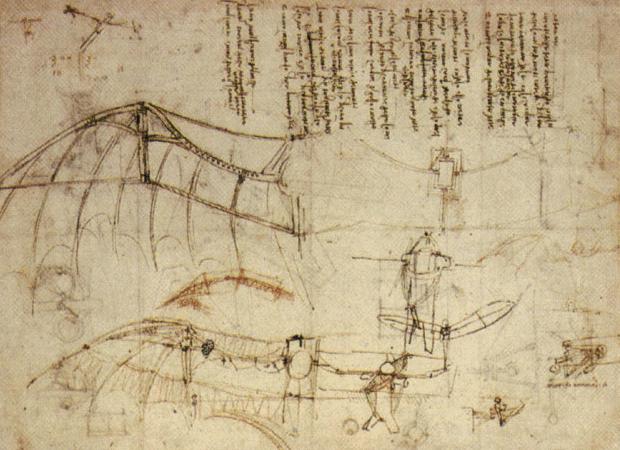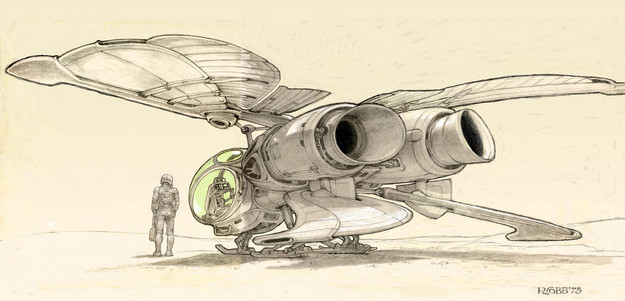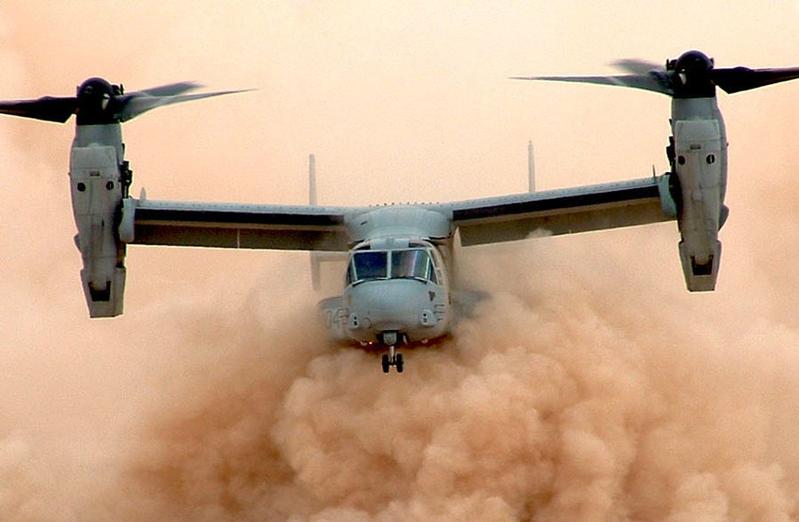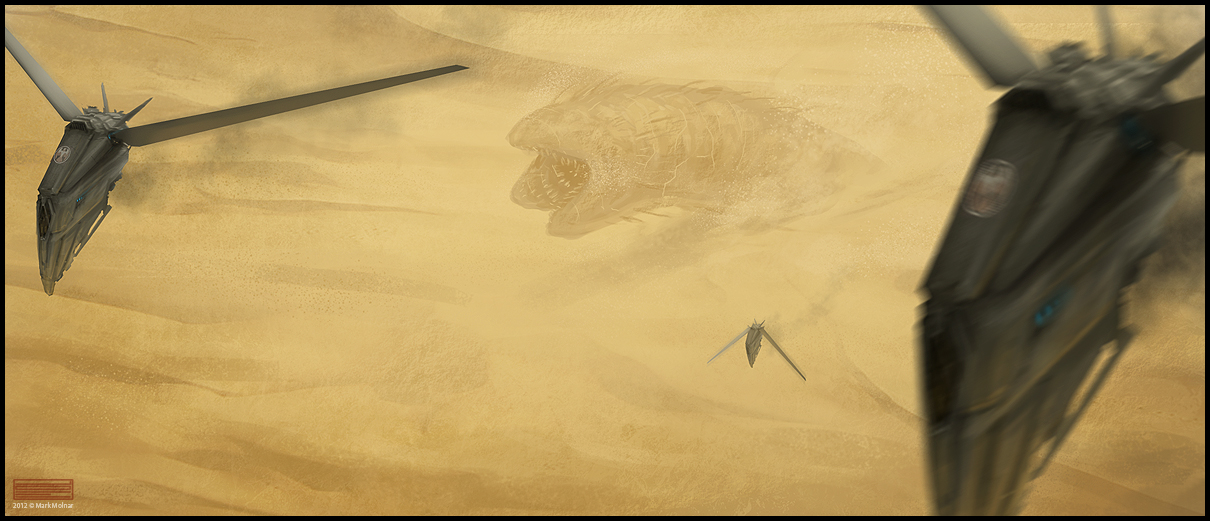Feasibility of a Dune Ornithopter
Dune Ornithopter
There are many different conceptual vehicles throughout science fiction, but Dune by Frank Herbert presents a very unique one, the ornithopter, a jet powered flapping wing aircraft. Like many modern technologies, this aircraft derives its characteristics from nature, who has spent thousands of years evolving, and perfecting its technologies. The ornithopter follows the natural form of a bird, which flaps its wings to fly as opposed to current aircraft designs that rely on engine thrust and aerodynamic lift. Original inception dates back to Leonardo da Vinci, but it is not until recently that we have been able to achieve these flight characteristics on small scales. This aircraft is used throughout Dune, both on Caladan and Arrakis, as a primary transportation aircraft, but the actual application of recreating nature's flapping wings has many complications, primarily material science and the inefficiency associated with this type of aircraft.
What is an Ornithopter
Benjamin J. Goodheart, a researcher at Embry Riddle for Aerospace Technologies, defines an ornithopter as a flapping winged aircraft that is generally designed after birds and insect's natural movement. This aircraft has been a dream of aviators for centuries, dating back as far as its original inventor, Leonardo da Vinci. Before him, the only flight attempted was gliding which had no introduction of thrusting forces that would allow the aircraft to sustain flight. In 1485, da Vinci began studying the flight characteristics of birds and figured that humans were too heavy and did not possess the strength required to flap wings and hence needed some type of machinery to make up for this lack of strength. Following this, he invented the ornithopter, which essentially used pulleys to translate hand and foot movement into movement of the wings. This device wasn't built until centuries later and proved to be ineffective at sustaining flight, but da Vinci's understanding of fluid mechanics and flight, gained from his observations, built the foundation for manned flight in the future.

Ornithopters in Dune
In Frank Herbert's, Dune, we are first introduced to the ornithopter by the first Reverend Mother during her tests of Paul, but we don't see it in action or get any description of it until Liet Kynes meets with Duke Leto. The aircraft is described as being similar to an insect that hums softly from the jets running in their idle state, "An unmarked ornithopter squatted nearby, humming softly on standby like a somnolent insect. (Herbert)" We get more evidence to the similarities to an insect and these aircraft from Hawat's perspective among the fremen, "The captured 'thopter took off with a lurching flap of wings, angled upward to the south in a steep, wing-tucked climb." The aircraft's wings are specifically described as flapping wings paralleling that of the ornithopter. A definite description showing the design of Dune's ornithopter is when Duke Leto is trying to save a group of Fremen from a worm on Arrakis, "He broke off as the Duke kicked on the jet brakes. The ship bucked as its tail pods whispered to silence. Stub wings elongated, cupped the air. The craft became a full 'thopter as the Duke banked it, holding the wings to a gentle beat. (Herbert)" The ornithopter is described as cupping the air the same way a bird's flapping would while the wings hold a gentle beat as they flap. A characteristic of these aircraft is their ability to hover similar to a flying insect or hummingbird, "Flame streaked upward to the hovering 'thopters." The other significant description of these aircraft is their use of jet propulsion, "Paul fed more power to the jetpods. The 'thopter banked, sinking them into their seats as a dark wall lifted against the stars ahead. He gave the craft more wing, more power. Another burst of lifting wingbeats and they came out over rocks. (Herbert)" This differs from the general definition of an ornithopter, which relies solely on the flapping action to produce thrust.

What it would require to do it in real life and why
From a typical citizen's perspective, a flapping wing device should be relatively simple, and fundamentally this is true. We have created flapping wing devices for years, but the problem comes in matching the performance and capabilities of Dune's ornithopters. From an engineering standpoint, we find two major limitations on achieving human flight modeled after birds. These are the ability to translate energy into thrust using these flapping wings and then the structural limitations. The purpose of the flapping wing on a bird, insect, or ornithopter is to create thrust. The body, after being thrusted forward, can sustain flight by simple aerodynamic manipulation through wing shape, the way it has been done for decades. The flapping motion moves air, imparting momentum on the body creating this thrusting force. This means that we would have to design wings that could flap at speeds that would be able to sustain the thrust force to keep the aircraft airborne while being structurally sound and as light as possible, a task easier said than done. Then comes the issue of hovering, which would require the wings to create a significant upward force equaling the weight of the aircraft. Following that, the structure of these wings must be considered. Aeronautical engineers have nearly perfected the design of fixed wings structure, but with a flapping wing, the wing is no longer fixed and is in a constant state of stress. There are generally two categories of stress, compression and tension, the pulling and pushing of material. With a flapping wing, the material will experience both these stresses on top of the other stresses associated with flowing air. This state of constant, high magnitude stress, leads to a very short fatigue life for the structure.
What we currently have that is closest
Despite the limiting factors in building ornithopters similar to the ones in the Dune universe, we have successfully built multiple ornithopters. The majority of them have been designed to address the unmanned surveillance needs for the military, but their principles follow the same ones Dune's ornithopters follow, flapping wings. One example includes the Harvard's RoboBee, which derives biological inspiration from bees using small flapping wings to propel it through space. There are numerous designs from university researchers and government/military programs all over the world that follow this model, but these do not match the size and capabilities of Dune's ornithopter. The next closest aircraft in modern times is the University of Toronto's Institute for Aerospace Studies ornithopter project led by Professor James DeLaurier. This aircraft is a single man aircraft that utilizes a small petroleum engine to manipulate wing movement into a flapping motion. This motion provides a component of thrust to propel the aircraft, and with the assistance of aerodynamic lifting bodies, the aircraft is able to fly. It is even fitted with a small jet to help with propulsion, similar to the jet powered ornithopters in Dune. The downside to this aircraft is it is extraordinarily slow, only carries one passenger, cannot hover, and is extremely inefficient. For these reasons the attempt to build a commercially available ornithopter was dropped, and there is little research in manned ornithopters. But there is one more aircraft that performs just as well as Dune's ornithopter, Boeing's V-22 Osprey. This aircraft has been in operation since 2007 and is basically two large propellers attached at the end of two wings, which can be articulated to point up, forward, or anywhere in-between. This aircraft does not fly using flapping wings, but matches Dune's ornithopters capabilities nearly exactly. It can fly, hover, and land just about anywhere, especially on sand, thanks to its articulating rotors. It carries 24 passengers and can fly with the speed and range of a normal aircraft, similar to Dune's ornithopter. It can't do any space travel, as the ornithopter is led on to be capable of, but the V-22 is the closest aircraft we have too Dune's portrayal to the ornithopter today.

What we need to get the real thing
The ornithopter is an aircraft that is by all means possible to build and fly, we have been doing so for years. The only problem is making one that matches Dune's ornithopter. This is currently not possible, and it will never be attempted. There is just no need for this type of aircraft, due to the inefficiency of a flapping wing as opposed to an engine propelled fixed wing aircraft. But if we were to build an ornithopter matching that of Dune, we would need to develop our understanding of dynamic mechanisms, making flapping wings, and material sciences. The mechanisms we have used for current ornithopters are not efficient enough to make a practical vehicle. On top of that, like many technologies based on nature, our currently available materials are not on par with the demand an ornithopter requires. Our materials don't possess the fatigue life that would be required for a financially economical aircraft while being able to withstand the forces that flapping wings experience and are within an acceptable weight. This includes current composites, such as carbon fiber, which have a very high strength to weight ratio but are extraordinarily complicated to estimate the fatigue life. If we can address these problems, to a point where we can surpass the efficiency of the fixed wing aircraft, the ornithopter will have a real chance, but until then there is no demand for such an aircraft.
Work Cited
Boeing. "V-22 Osprey." Boeing. Boeing, 1 Jan. 2015. Web. 1 Mar. 2015. <http://www.boeing.com/boeing/rotorcraft/military/v22/>.
Doncieux, Stephane, Jean-Baptiste Mouret, Laurent Muratet, and Jean-Arcady Meyer. "The ROBUR Project: Towards an Autonomous Flapping-wing Animat." LIP6 - AnimatLab (2005). Paul Sabatier University. Web. 1 Mar. 2015.
Goodheart, Benjamin. "Tracing the History of the Ornithopter: Past, Present, and Future." Journal of Aviation/Aerospace Education & Research 21.1 (2011). Embry Riddle Aeronautical University. Web. 1 Mar. 2014. <http://commons.erau.edu/jaaer/vol21/iss1/8>.
Herbert, Frank. Dune. Philadelphia: Chilton, 1965. Print.
Jakab, Peter. "Leonardo Da Vinci and Flight." Smithsonian's National Air and Space Museum. The National Air and Space Museum, 22 Aug. 2013. Web. 1 Mar. 2015. <http://blog.nasm.si.edu/exhibitions/leonardo-da-vinci-and-flight/>.
Kerman, K. "RoboBees." Harvard University. Harvard University, 1 Jan. 2012. Web. 1 Mar. 2015. <http://robobees.seas.harvard.edu/>.
NASA. "How Did We Learn to Fly Like the Birds?" National Aeronautics and Space Administration. NASA. Web. 1 Mar. 2015. <http://www.grc.nasa.gov/WWW/k-12/UEET/StudentSite/historyofflight.html>.
Sanderson, Jack. "Project Ornithopter." Project Ornithopter. University of Toronto Institute for Aerospace Studies, 1 Jan. 2006. Web. 1 Mar. 2015. <http://www.ornithopter.net/index_e.html>.
